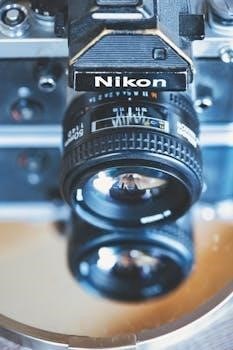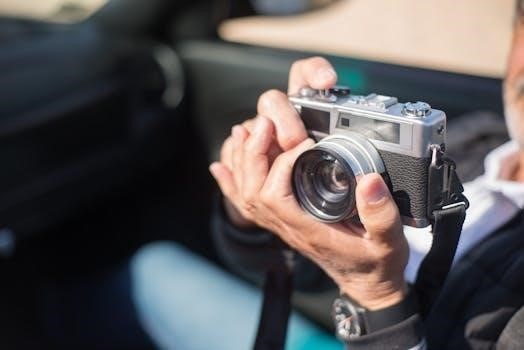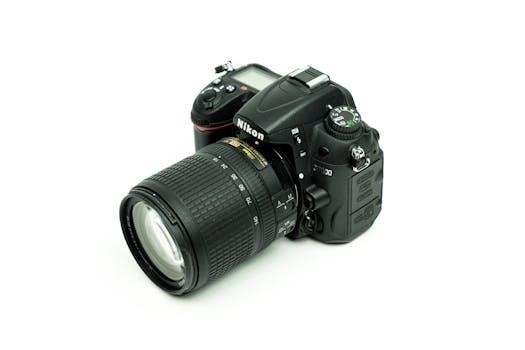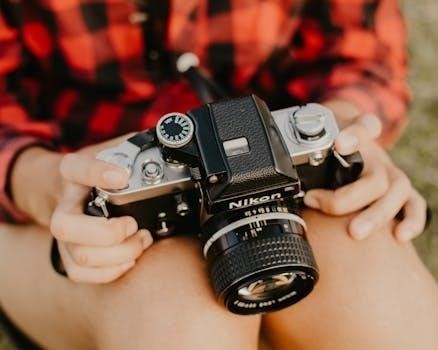
Nikon Coolpix manuals are essential guides for users seeking to maximize their camera’s potential. These documents provide crucial information on operation and features; They ensure a smooth photography experience. Understanding your specific model is key. Manuals cover everything from basic to advanced functions.
Understanding the Importance of User Manuals
User manuals for Nikon Coolpix cameras are vital for both novice and experienced photographers. These manuals serve as a comprehensive guide, unlocking the full functionality of your device. They help you understand everything, from basic setup to advanced features. Ignoring the manual can lead to missed opportunities and a less than optimal experience with your camera. The manuals provide detailed, step-by-step instructions on how to operate your camera correctly. They ensure that you are able to utilize all the features that your specific model offers. Proper understanding of your Nikon Coolpix will ultimately enhance your skills and allow you to capture stunning photos and videos. These documents are also essential for troubleshooting issues. They help you avoid potential damage to your device. By consulting the user manual, you can ensure that you get the most out of your Nikon Coolpix camera. This maximizes the value of your investment and enhances the quality of your photography.

Finding Your Specific Nikon Coolpix Manual
Locating the correct manual for your Nikon Coolpix camera is crucial. This ensures you receive accurate information. Begin by identifying your exact camera model. Then, utilize online resources or the Nikon website to find the corresponding manual.
Identifying Your Camera Model
Before you can effectively use a Nikon Coolpix manual, it’s essential to accurately identify your specific camera model. This is because each model, from the older Coolpix 995 to the newer P1000, has unique features and settings. Locating the model number is usually the first step. Typically, this can be found on the camera body itself. Look closely near the lens, on the bottom of the camera, or inside the battery compartment. The model number is often printed in small text, or sometimes it’s on a sticker. Once you have this information, you can easily search for the correct manual. Having the precise model ensures you’re using a manual with the right instructions for your camera’s functions, buttons, and features. This step is vital for avoiding confusion and effectively using your Coolpix. Knowing the correct model is paramount for utilizing all the unique capabilities your camera offers. This ensures you are using the right guide for your specific device.
Online Resources for Manuals
Finding your Nikon Coolpix manual online is straightforward due to the numerous resources available. The primary source is Nikon’s official website, which hosts a vast library of manuals for all their camera models. These are usually available as downloadable PDF files. Make sure you locate the specific section for your camera model to avoid getting the wrong manual. Other reliable websites also offer Nikon manuals, including sites dedicated to camera equipment or those offering product support. Always double-check the source’s credibility. When downloading a manual, ensure it is the correct language and version. Many third-party websites also provide user guides and community forums. These can provide additional support. They may have tips and tricks from other users. Be cautious of unofficial sources to avoid inaccurate or outdated manuals. Using online resources offers quick access to the information you need. It allows for easy reference on your computer, tablet, or smartphone. This ensures you always have your manual at hand.

Navigating the Nikon Coolpix Manual
Effectively using a Nikon Coolpix manual involves understanding its layout. Typically, manuals begin with basic operations. Later sections cover advanced features and settings. Use the table of contents for quick navigation.
Basic Camera Operations
The Nikon Coolpix manuals typically dedicate a significant portion to explaining basic camera operations, which are crucial for new users. This section covers fundamental tasks such as powering the camera on and off, inserting and removing the battery and memory card, and setting the date and time. You’ll find detailed instructions on how to navigate the camera’s menu system, which is often the starting point for most actions. The manual will guide you through selecting different shooting modes, like auto mode for simple point-and-shoot photography, and how to use the zoom function. Additionally, it includes information on focusing techniques and how to capture your first picture. The manuals also explain the basic functions of the different buttons and dials on your camera, ensuring that you can quickly access the necessary settings. You might discover how to review your images, delete unwanted shots, and adjust the LCD brightness using this section. Understanding these basic operations is the foundation for exploring the more advanced capabilities of your Nikon Coolpix.
Advanced Features and Settings
Once familiar with the basics, the Nikon Coolpix manual unveils a world of advanced features and settings. This section delves into more complex functionalities, allowing users to fine-tune their photography. You’ll discover how to use various scene modes to optimize settings for specific conditions like portraits or landscapes. The manual explains manual shooting modes, granting control over aperture and shutter speed. It covers ISO settings, which affect image sensitivity to light, and white balance adjustments for accurate color representation. This section also details advanced focusing options, such as continuous autofocus. The manual will show you how to use features like exposure compensation to adjust brightness. Furthermore, it explains special effects and creative filters. Understanding these features will empower you to take more creative and technically accomplished photos. This section is crucial for those who want to go beyond simple snapshots.
Troubleshooting with the Manual
Nikon Coolpix manuals are invaluable for troubleshooting camera issues. They offer solutions to common problems and explain error messages. This section helps users quickly resolve technical difficulties and ensures smooth operation.
Common Issues and Solutions
Nikon Coolpix users may encounter several common issues, and thankfully, the user manual often provides solutions. Problems like a camera that won’t turn on could stem from a depleted battery or improper battery insertion. The manual will guide you on correct battery handling. If you experience blurry images, check if the lens is clean and if the image stabilization feature is enabled. For memory card errors, try reformatting or using another compatible card. Sometimes, the camera might freeze; refer to the manual for steps on how to reset. Overexposed or underexposed photos can be corrected by adjusting the exposure settings, which the manual explains in detail. If you find that the flash is not working, ensure it’s not disabled and that the flash mode is set appropriately. By consulting the manual, many of these common issues can be resolved quickly, allowing you to get back to capturing great moments.
Understanding Error Messages
Nikon Coolpix cameras, like any electronic device, can display error messages. These messages are crucial for diagnosing problems. The user manual is your best resource for understanding these codes. Common errors include “No Memory Card,” which indicates either the absence of a card or an incompatibility issue. “Card Full” means that you need to transfer files or delete some images. Error messages like “Lens Error” suggest a problem with the lens mechanism. “Battery Exhausted” signifies a low battery level. It’s important to avoid panic and refer to the manual for specific explanations of the error code you are seeing. The manual will provide steps on how to fix the problem. Often, errors can be resolved through simple troubleshooting. Understanding these messages enables you to quickly address the problem and continue using your camera effectively. Ignoring error messages could lead to more serious issues, so always consult the manual.

Maintaining Your Nikon Coolpix
Proper maintenance ensures your Nikon Coolpix camera’s longevity. This involves careful handling of the battery and memory card. Following cleaning instructions is also essential. Regular care prevents damage and ensures optimal performance. Always consult your manual for specific guidelines.
Battery and Memory Card Handling
Proper battery and memory card handling are critical for maintaining your Nikon Coolpix camera’s performance and longevity. Always refer to your specific model’s user manual for detailed instructions on how to correctly insert and remove the battery. Mishandling can potentially damage both the camera and the battery itself. When inserting the battery, ensure it is oriented correctly, aligning with the indicated polarity markings. Avoid forcing the battery into place, as this could cause damage to the battery compartment or the battery itself. Similarly, when removing the battery, follow the recommended procedure to prevent any accidental damage. For memory cards, always use compatible types and sizes. Avoid inserting or removing them forcefully. When inserting, make sure it clicks into place securely; when removing, ensure the card is released properly before pulling it out. Incorrect handling of memory cards can result in data loss, or damage to the card or the camera’s memory card slot. Store both batteries and memory cards in a clean and dry environment when not in use.
Care and Cleaning Instructions
Maintaining your Nikon Coolpix camera involves careful cleaning and handling to ensure its longevity and optimal performance. Always consult your specific model’s manual for detailed instructions. Start by powering off your camera before cleaning. Use a soft, dry, lint-free cloth to gently wipe the exterior surfaces, avoiding any abrasive materials. For stubborn smudges, slightly dampen the cloth with water, never directly apply liquid to the camera. Avoid using harsh chemicals, solvents, or cleaning agents, as they can damage the camera’s finish and internal components. For the lens, use a lens cleaning cloth or a lens pen specifically designed for camera lenses. Avoid touching the lens with your fingers. Store your camera in a clean, dry place when not in use, ideally in a camera bag. Protect it from extreme temperatures, humidity, and dust. Regular cleaning and appropriate storage can significantly extend the life of your Nikon Coolpix camera.

Advanced Nikon Coolpix Usage
Exploring advanced features enhances photography skills. These manuals detail special shooting modes and connection options. Learn to utilize features for creative control. Connecting to other devices broadens sharing capabilities. Master your camera through advanced guidance.
Utilizing Special Shooting Modes
Nikon Coolpix cameras often feature various special shooting modes that can significantly enhance your photography. These modes are designed to optimize camera settings for specific scenarios, allowing users to capture the best possible images with ease. For instance, a “Scene Mode” might include options like “Portrait,” “Landscape,” “Night,” and “Sports,” each adjusting parameters like aperture, shutter speed, and ISO to suit the subject matter. The “Panorama” mode assists in creating wide, sweeping images by seamlessly stitching together multiple shots. Understanding these modes is crucial for unlocking the full creative potential of your Coolpix camera. Moreover, the user manual provides detailed explanations of each mode, helping you choose the right one for various shooting situations. Utilizing these special modes can simplify complex photographic tasks and elevate your photography from simple snapshots to impressive captures. This section will help you understand and use these modes efficiently. Refer to your specific manual for model-specific instructions and options.
Connecting to Other Devices
Nikon Coolpix cameras offer various connectivity options, enabling users to transfer photos and videos to other devices. These connections often include USB ports for direct transfer to computers, allowing for easy management and editing of captured content. Some models also support Wi-Fi or Bluetooth, facilitating wireless connections to smartphones or tablets. The SnapBridge app, for example, allows for seamless image transfer and remote camera control. Furthermore, the HDMI output lets you view photos and videos on larger screens like televisions or monitors, enhancing the viewing experience. Understanding these connection methods will greatly improve your ability to share your work quickly and easily. The user manual provides step-by-step instructions for setting up and utilizing each connection type. Therefore, consulting the manual will ensure you can effectively manage and display your images across multiple platforms. Make sure you refer to your specific model manual for particular information about connectivity. This allows you to maximize your camera’s connectivity potential.